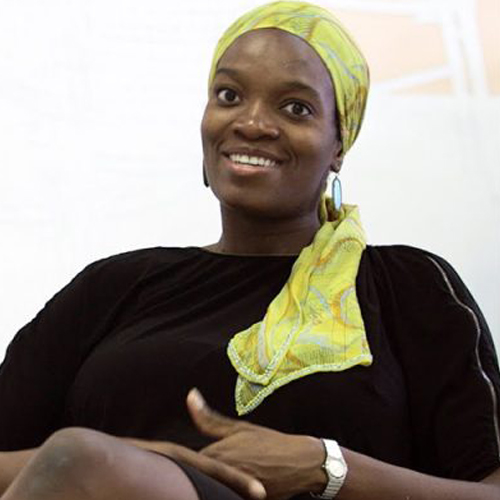
Born and raised in Nigeria, Njideka Akunyili Crosby studied at Swarthmore College, the Pennsylvania Academy of the Fine Arts, and Yale University, and her subject matter, references, and sentiments are informed by these diverse cultural sources. Her diasporic experience, her continued contact with her homeland and its cultural and social complexities, and her marriage to a white American all shape her subjects and narratives. In her methods, materials, and stylistic influences, Akunyili Crosby shows a deep awareness of contemporary artists from Robert Rauschenberg to Kerry James Marshall, while her visual vocabularies suffuse intimate domestic scenes with the products and riotous patterns of her African homeland. Akunyili Crosby produces large-scale drawings and paintings, frequently of interiors that suggest familiar narratives but retain elements of mystery and ambiguity. These scenes are often directly inspired by the artist’s own experiences and memories, and are populated by her family members, friends, and people she has met or recalls from back home.
In composing her works, Akunyili Crosby combines sources from different worlds, mixing family photographs from Nigeria with an interior of her own apartment. Each element is broken down into constituent parts (figures, furniture, background, surrounding spaces), transferred onto transparent films, and projected and retraced onto the final support. During this process she considers and finalizes crucial decisions about the details of the scene. She also makes deliberate and complex use of transfer prints, using a mineral-based solvent to transfer photocopied images from newspapers and product catalogues, magazines and books, onto the support. (Rauschenberg used this technique to great effect in his work starting in the late 1950s.) Akunyili Crosby layers these transfers, creating dense patterns that may move from a figure to parts of a piece of furniture, a background wall, a carpet, or an architectural element, creating an atmosphere of tension and instability. The transferred images are drawn from a wide variety of sources, ranging from colonial-era portraiture through recent popular culture to the intricately detailed Dutch wax-print fabrics produced by the Dutch manufacturer Vlisco for the African market, and they often directly reference Nigerian and African-diaspora culture.
In And We Begin to Let Go, a young Black woman, seen in profile, sits in an ornate armchair while a male figure standing behind her bends over to whisper into or kiss her hidden left ear. While her face, neck, and arms are bare and dark-skinned, his torso is rendered more ambiguously: his short-sleeved T-shirt is a flat monochrome on the shoulders and back, while the front is adorned with densely patterned fragments of transferred images, which also cover his bare elbow and lower arms. Only part of his right arm is rendered in a color approximating white skin, suggesting that this male figure is white.
The chairs and floor are also covered in densely patterned images. The man’s address appears tender, but just as well could be understood to be more ambiguous, whispering a warning or instruction in the woman’s ear. Her downcast eyes and heavy lids could equally be seen as sensual and dreamy or sullen, stoic, even resentful. The work contains all the hallmarks of Akunyili Crosby’s breakout body of work, which she started making in 2010 and was first shown in 2013, and which presented her as a developed, formally inventive storyteller. Her particular strength is in conveying a mood that hovers between intimacy and longing, discovery and loss.


 Argoon Art | Sell online in the simplest way possible
Argoon Art | Sell online in the simplest way possible







